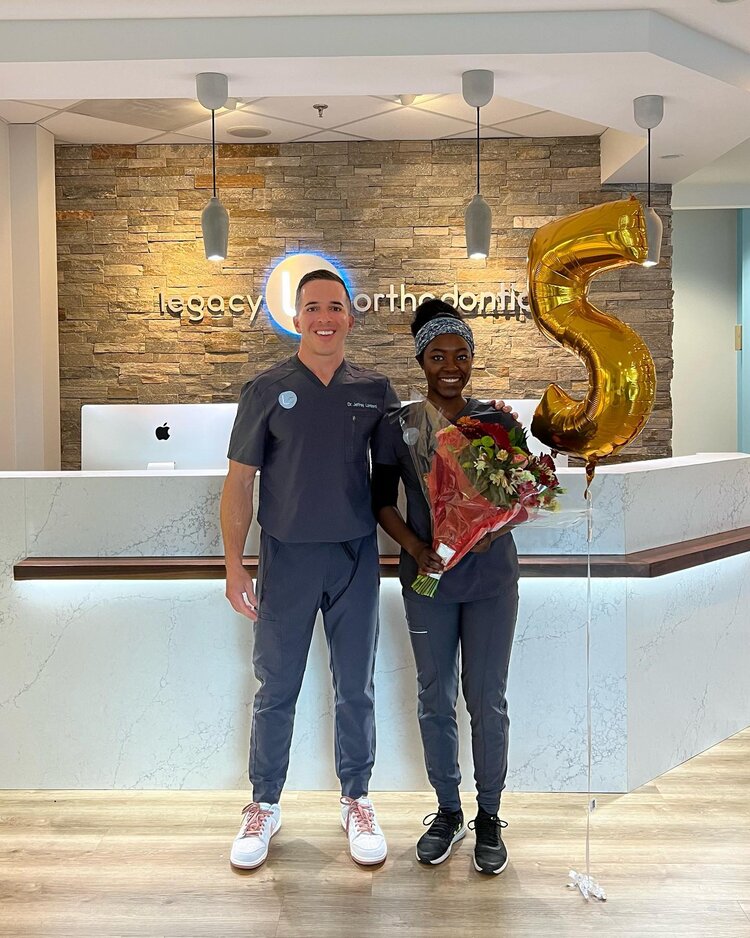Legacy Orthodontics - Truths
Legacy Orthodontics - Truths
Blog Article
How Legacy Orthodontics can Save You Time, Stress, and Money.
Table of ContentsGetting The Legacy Orthodontics To WorkThe smart Trick of Legacy Orthodontics That Nobody is Talking AboutNot known Details About Legacy Orthodontics What Does Legacy Orthodontics Mean?The Best Strategy To Use For Legacy Orthodontics
In addition, we use flexible therapy routines, versatile payment options and a fun, pleasurable experience.An orthodontist is a dental practitioner educated to identify, avoid, and treat teeth and jaw irregularities. They correct existing conditions and are educated to determine troubles that might create in the future. Orthodontists function with individuals of all ages, from youngsters to adults. Individuals often link a best smile with healthiness.
Malocclusion, or misaligned teeth, can lead to oral problems, including tooth degeneration, gum illness, and hard or unpleasant chewing. Not everybody is birthed with straight teeth. If you have a poor bite or big rooms between your teeth, you may wish to seek advice from a dentist specializing in orthodontic treatment.
Rumored Buzz on Legacy Orthodontics
( Picture Credit Rating: DigitalVision/Getty Images) Orthodontists utilize dealt with and detachable dental tools, like dental braces, retainers, and bands, to transform the position of teeth in your mouth. Orthodontic treatment is for dental irregularities, consisting of: Jagged teethBite problems, like an overbite or an underbiteCrowded teeth or teeth that are also much apartJaw misalignmentThe goal of orthodontic treatment is to boost your bite.
A healthy and balanced bite guarantees you can consume, chew, and speak effectively. While you might believe of orthodontists as primarily for children or teens that need braces, they can remedy oral troubles at any kind of age. Orthodontists attend college, dental school, and orthodontic institution. After college graduation, they invest 2 or 3 years in an orthodontic residency program.
, yet not all dental practitioners are orthodontists. They focus on 2 locations: Just how to effectively and securely move teeth Just how to properly guide growth in the teeth, jaw, and faceOnce an orthodontist has completed training, they have the alternative to end up being board licensed.
Some Known Incorrect Statements About Legacy Orthodontics
Misalignment, or malocclusion, is the most typical reason individuals see an orthodontist. It is hereditary and is the result of dimension differences in between the upper and reduced jaw or in between the jaw and teeth. Malocclusion causes tooth overcrowding, a twisted jaw, or irregular bite patterns. Malocclusion is usually treated with: Your orthodontist attaches metal, ceramic, or plastic square bonds to your teeth.
If you have just minor malocclusion, you might have the ability to use clear dental braces, called aligners, rather than standard braces (https://legacyortho1.weebly.com/). Some individuals require a headgear to assist relocate teeth into line with pressure from outside the mouth. After braces or aligners, you'll need to wear a retainer. A retainer is a custom gadget that keeps your teeth in location.
They're frequently made use of on kids. They can produce added space in the mouth without having to draw teeth. If you have a major underbite or overbite, you could need orthognathic surgical treatment (additionally called orthodontic surgery) to lengthen or shorten your jaw. Orthodontists make use of cords, surgical screws, or plates to support your jaw bone.
You might require to see an orthodontist if you have: Crowding or otherwise enough room for all of your teethOverbite, when your upper teeth come by your base teethUnderbite, when your base teeth are also much forwardSpacing or issues with gapsCrossbite, which is when your upper teeth fit behind your base teeth when your mouth is closedOpen bite or a vertical void between your front base and upper teethMisplaced midline, when the center of your base and top teeth don't line up Correcting a dental malocclusion can: Make attacking, chewing, and speaking easierImprove the balance of our face and your general appearanceEase pain from temporomandibular joint disordersDifferent your teeth and make them much easier to cleanse, helping avoid dental caries or dental caries It's commonly a dental expert that initially notifications misaligned teeth throughout a routine test.
What Does Legacy Orthodontics Do?

During your first orthodontic appointment, you'll likely have: A dental examPhotos taken of your face and smileDental X-raysPanoramic (360 degree) X-rays of your face and headImpressions to develop molds of your teethThese tests will help your orthodontist understand just how to continue with your therapy. leesburg invisalign. An orthodontist is a dentist that's had training to treat your teeth and jaw
An orthodontist is concentrated on your bite, so something like a cracked tooth would be handled by a dentist. Orthodontists are concentrated on your bite, or the way your teeth fit with each other, and the straightness of your teeth.
Ever wondered just how celebrities constantly appear to have completely straightened teeth? Orthodontists are oral professionals that focus on remedying irregularities in the teeth and jaws.
3 Easy Facts About Legacy Orthodontics Shown

, orthodontists have a diverse toolkit at their disposal. These tried-and-true braces make use of a system of brackets adhered to the teeth and linked by cables.
Clear aligners, like Invisalign, are a preferred option for clients seeking a much more very discreet therapy alternative. These detachable trays are tailor-made to gradually change the teeth's setting. Headgear might be utilized in conjunction with braces or aligners to use additional targeted forces, especially for fixing jaw discrepancies. In situations of narrow jaws, palatal expanders can be made use of to produce room for correct tooth alignment.
Report this page